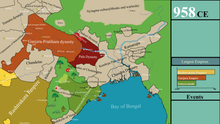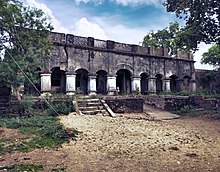The Bhanja dynasty is a dynasty that originated in the northern and central regions of modern Odisha (in the Khiching region of Utkala and Khinjali mandalas) before the Gupta Empire became an imperial power. The dynasty, of ancient local Kshatriya lineage as documented by Hermann Kulke, succeeded the Vindhyatabi branch of the Nagas of Padmavati, who ruled from the Keonjhar district of Odisha and included Satrubhanja of the Asanpat inscription. The Bhanj later became feudatories of the Bhauma-Kara dynasty.

The successor branches of the Bhanja rulers became local feudatories to the united realms of the Eastern Ganga dynasty, the Gajapati Kingdom, and ruling dynasties of the princely states and zamindaries of the region with the advent of British rule. Prominent branches include the princely states of Mayurbhanj State and Keonjhar State.
History
The early Bhanjas emerged as leading chieftains succeeding the Nagas of the Vindhyatabi rulers in Kendujhar and the Western Odisha region, inheriting the land that consisted of the preceding Naga ruler Satrubhanja's domains. With the supremacy of Bhauma-Kara dynasty rule in the Utkal region, they ruled as their feudatories which consisted of mandalas.
According to early mandala inscriptions, the Bhanjas describe their origins from the mythical peahen likely pointing out to the early peafowl-related traditions of the ancient Bhanja clans, which is observed on their emblems that are shared by the successive branches. Khinjali and Khijjinga mandalas were among the prominent mandalas under Bhauma-Kara rule.
Khinjali mandala
The Khinjili mandala comprised areas of modern-day Boudh, Phulbani, Nayagarh, Ghumusar, and Sonepur. Its capital was Dhritipura (modern Boudh). Nettabhanja, who ruled over the Dhenkanal-Anugul region and made Nava-angulakapatana his capital, was regarded by R. D. Banerji and R. C. Majumdar as the earliest Bhanja king of the Khinjali mandala line. The early Bhanjas were powerful feudatory rulers of independent sovereign principalities in early medieval Odisha, and the territory was passed to the Somavanshis after Ranabhanja, then his son Netribhanja established a new territory named after Khinjali. Copper plate inscriptions of Yasobhanja and his brother Jayabhanja at Antirigam and Kanakabhanja show Bhanja rule continued in the Khijali region until the 12th century CE.
During the early 10th century CE, with political instabilities in the Bhauma-Kara kingdom, the neighboring Somavamshi and Bhanja dynasties attempted to conquer the region. The Bhanjas of Khinjali married two of their princesses (Vakula Mahadevi and Dharma Mahadevi) to the Bhauma-Kara kings Shubhakaradeva V and his father Shantikaradeva III, and later controlled the Bhauma-Kara kingdom through them. The Bhauma-Kara territory eventually came under the control of the dominant Somavamshis.
Early Bhanjas of Khinjali mandala
- Silabhanja I (8th-century CE)
- Satrubhanja (8th-century CE)
- Ranabhanja (9th-century CE)
- Netribhanja I (Nettabhanja I)
- Digbhanja
- Silabhanja II
- Vidyadharbhanja
- Nettabhanja II
Baudh Bhanjas of Khinjali mandala
- Solana Bhanja
- Durjaya Bhanja
- Kanaka Bhanja
Later Bhanjas of Khinjali mandala
- Devabhaja
- Rayabhanja I
- Virabhanja
- Rayabhanja II
- Yasobhanja (12th cen CE)
- Jayabhanja (12th cen CE)
- Virabhanja II
Khijjinga mandala
Khijjinga, or Khijjinga-Kotta, comprised areas of modern-day Mayurbhanj and Kendujhar. Inscriptions refer to them as the founders of the Adi-Bhanja dynasty. The early history of Bhanja rule at Khijjinga is described in copper plate inscriptions found at Bamanghaty near Rairangpur and the Khandadeuli inscription of Ranabhanja. The founder of the dynasty was Virabahdra Adi Bhanja, with his capital located at Khijjinga Kota (now Khiching). The Kichakeshwari Temple was also built by Rajabanja, according to inscriptions.
- Virabhadra Adi-Bhanja (eighth-century CE)
- Kottabhanja
- Digbhanja
- Rajabanja
- Ranabhanja (924 CE Bamanghaty inscription)
- Narendrabhanja
Bhaumakara kingdom
Two princesses of the Khinjali Bhanjas, Vakula Mahadevi and Dharma Mahadevi, married the Bhauma-Kara kings Shubhakaradeva V and his father Shantikaradeva III, and later became the regnal monarchs of the Bhauma-Kara kingdom.
- Vakula Mahadevi (934–940)
- Dharma Mahadevi (940–943)
Bhanja successor states
- Ancient Bhanja clans
- Khijjinga mandala
- Mayurbhanj branch
- Kanika branch
- Bastar branch
- Garh Haladia branch
- Keonjhar branch
- Mayurbhanj branch
- Khinjali mandala
- Baudh branch
- Daspalla branch
- Ghumusar branch
- Baudh branch
- Khijjinga mandala
Mayurbhanj branch
Main article: Mayurbhanj StateThe influence of the Khijjinga Bhanjas declined after the dominance of the Somavamshis in the Utkal region, but centuries later came back to prominence in the region with the rise of the Eastern Ganga dynasty after uniting the three realms of Trikalinga with the Bhanjas as their feudatories. Traditions point to numerous origins of the dynasty, but a lack of records renders them unlikely although it is generally accepted that the founder, Adi Bhanja of the 8th century CE established the dynasty of the Mayurbhanj state with his brother Jyoti Bhanja founding the Keonjhar State succeeding from the Khijjinga Adi Bhanja dynasty.
Kanika branch
See also: Kanika Palace
The Kanika Bhanja branch was established by Bhujabal Bhanja most likely around the third century. It remained a prominent zamindari during the reigns of the Trikalingapati and Gajapati monarchs and also supported the Khurda rulers against the British after they took over Orissa from the Maratha Empire in 1803. After independence in 1947, it was merged into Odisha, following which the zamindari estates were abolished.
Bastar branch
Main article: Bastar stateThe Bastar state was long ruled by the descendants of the Kakatiya dynasty until the 1920s, when King Rudra Pratap Deo's daughter and heir Rani Prafulla Kumari Devi married Prince Prafulla Chandra Bhanj Deo, who was the nephew of the King of Mayurbhanj Sriram Chandra Bhanj Deo. Their son Pravir Chandra Bhanj Deo became the first and only Bhanja ruler of Bastar from 1936 until 1948 when it acceded to India following independence.
Garh Haladia branch

The Haladia estate was an ancient vassal state of the Gajapati Empire that was ruled on their behalf by the Bhanj monarchs. They are a branch of Mayurbhanj State who swore allegiance to the Gajapati Maharaja of Puri. It was founded by Anu Bhanj Deo, a scion of the Mayurbhanj Raj family who came to Puri around the 11th century CE, married the daughter of the then-Gajapati Maharaja of Puri, and obtained the estate as her dowry. During British rule, Garh Haladia was one of the Khandayat jagirs in Khordha.
Keonjhar branch
Main article: Keonjhar State
According to traditions, Keonjhar State was founded sometime during the 12th century during the rule of the Eastern Ganga dynasty when Jyoti Bhanj was enthroned as the raja of Keonjhar with the help of dominant local Bhuyan clans. The influence of Bhuyans on the enthronement rituals and regnal traditions of Keonjhar suggests a long-standing relationship with the kingdom.
Baudh branch
Main article: Baudh StateWith the advent of Eastern Ganga rule over the region after the defeat of the Somavamshis, there were local chieftains ruling over Baudh as Eastern Ganga feudatories. There was a Brahmin chieftain who was childless that adopted the nephew of the neighboring raja of Keonjhar who belonged to the Bhanj dynasty. The prince named himself Ananga Deva and became the king of Baudh in the 14th century.
Daspalla branch
Main article: Daspalla StateIn the late 15th century around 1498 CE, Naren Bhanja, the brother of the raja of Baudh, was made chieftain of the Daspalla region, from which he later seceded and declared his independent kingdom.
Ghumusar branch
The rulers of Ghumusar zamindari were descendants of the Bhanja rulers of Khinjali mandala whose rule ended in the Boudh region as the Somavanshis conquered their territory during their conflicts with the Bhauma-Kara rulers during the 10th century CE and were displaced into the Ghumusar region post-12th century where they set up their kingdom. They established their capital at Kulad (a place near Bhanjanagar). Ghumusar Bhanja rulers significantly contributed to the development of Odia literature during the Riti Yuga/Bhanja Yuga phase like Balabhadra Bhanja, Tribikram Bhanja, Dhanajaya Bhanja, Ghana Bhanja and Kabi Samrat Upendra Bhanja. The Ghumusar branch ended during the rule of Dhananjaya Bhanja II in 1835, when the British annexed the Ghumusar region after suppressing the Ghumusar rebellion of 1835–36.
Gallery
-
 Kichakeshwari Temple at Khiching
Kichakeshwari Temple at Khiching
-
 File:Kechakeshari temple, Khiching
File:Kechakeshari temple, Khiching
-
 Shri Hari Baladev Jiu Temple, Baripada
Shri Hari Baladev Jiu Temple, Baripada
See also
References
- Kulke, Hermann. Kshatriyaization and social change: A Study in Orissa setting. p. 404. OCLC 1236863278.
- Kulke, Hermann (1993). Kings and Cults: State Formation and Legitimation in India and Southeast Asia. Manohar Publishers & Distributors. p. 116. ISBN 9788173040375.
the Bhanja families of Mayurbhanj, Keonjhar, Baudh, Ghumsur and Kanika are linked with the ancient Bhanjas who had ruled in several branches over parts of northern Orissa, the central Mahanadi valley and southern Orissa since the late centuries of the first millennium AD.
- Inscriptions of Orissa: Circa 5th-8th centuries A.D, Volume 1. Delhi: Motila Banarsidass Publishers Private Limited. 1997. pp. 171–172. ISBN 81-208-1077-5.
- "ORIGIN, GENEALOGY AND CHRONOLOGY OF THE BHANJAS". www.shodhganga.inflibnet.ac.in. pp. 74, 75. hdl:10603/191656. Retrieved 7 May 2018.
- Agrawal, Ashvin (1989). Rise And Fall Of The Imperial Guptas. Motilal Banarsidass. p. 60. ISBN 9788120805927. Retrieved 2 March 2021.
- Sinha, S.; Centre for Studies in Social Sciences (1987). Tribal polities and state systems in pre-colonial eastern and north eastern India. Centre for Studies in Social Sciences, K.P. Bagchi & Co. p. 44. ISBN 978-81-7074-014-8. Retrieved 13 April 2020.
- Yoshī, A. (1983). History & Culture of Khijjingakotta Under the Bhanjas. Vikas Publishing House. p. 53. ISBN 9780706914337. Retrieved 13 April 2020.
- Umakanta Subuddhi (1997). "Economic Life of Orissa under the Bhauma-Karas". In Nihar Ranjan Patnaik (ed.). Economic History of Orissa. Indus. ISBN 978-81-7387-075-0.
- Chanda, Ramapradas (1929), Bhanja Dynasty of Mayurbhanja and their ancient capital at Khiching, AD, Mayurbhanj
- ^ Sahu, NK (1956), "The Bhanja Kings of Orissa", Proceedings of the Indian History Congress, 19, Indian History Congress: 130–131, JSTOR 44140816
- Das Gupta, Charu Chandra (1931), "Some Notes on the Ādi-Bhañjas of Khijjiṅga Koṭṭa, Earlier Bhañjas of Khiñjali-Maṇḍala, Bhañjas of Bauda and Later Bhañjas of Khiñjali", Annals of the Bhandarkar Oriental Research Institute, 12 (3), Bhandarkar Oriental Research Institute: 231–245, JSTOR 41694027
- Acharya, Subrata Kumar (1991). "Identification of Shilabhanjadeva of the Madras Museum Plates of Narendradhavala". Proceedings of the Indian History Congress. 52: 1026–1029. JSTOR 44142745.
- ^ Walter Smith 1994, p. 23.
- Chanda, Ramapradas (1929), Bhanja Dynasty of Mayurbhanj a and their ancient capital at Khiching, AD, Mayurbhanj, p. 26
- ODISHA DISTRICT GAZETTEERS MAYURBHANJ (PDF), GAD, Govt of Odisha, 1990, pp. 61–66
- Hemanta Kumar Mohapatra (August 2005). "Oriya Speaking Feudatory States" (PDF). Orissa Review.
- ODISHA DISTRICT GAZETTEERS KENDRAPARA (PDF), GAD, Govt of Odisha, 2012
- "Indramani Devi And Others vs Raghunath Bhanja Birbar Jagadeb".
- Department, Bengal (India) Land Records and Agriculture (1899). Report on the Khurda Settlement of 1897-98. Bengal Secretariat Press. p. 12.
- Cornelia Mallebrein (2010). "Sitting on the Tribal Chief's Lap Coronation Rituals in Ex-Princely States of Orissa". University of Tubingen.
- ODISHA DISTRICT GAZETTEERS BOUDH (PDF), GAD, Govt of Odisha, 1991, p. 23
- Imperial Gazetteer of India, v. 7, p. 140.
- Malleson, G. B. An historical sketch of the native states of India, London 1875, Reprint Delhi 1984
- ODISHA DISTRICT GAZETTEERS NAYAGARH (PDF), GAD, Govt of Odisha, 2015, p. 42
- Jadumani Mahapatra (December 2013). "REMAPPING OÒRA: THE LAND AND THE PEOPLE" (PDF). Odisha History Congress. p. 20. Archived from the original (PDF) on 3 September 2018. Retrieved 3 March 2021.
- Mansingha, Mayadhar (1960). "History of Oriya Literature". Sahitya Akademi.
- Rabindra Nath Dash (August 2016). "Ghumsar Resistance Against British Imperialism" (PDF). Odisha Review.
- "Explained: Who were the Paikas of Odisha, and what will the Paika Memorial celebrate". The Indian Express. 9 December 2019.
Further reading
- Walter Smith (1994). The Mukteśvara Temple in Bhubaneswar. Motilal Banarsidass. ISBN 978-81-208-0793-8.
- Umakanta Subuddhi (1978). The Bhauma-Karas of Orissa. Punthi Pustak. OCLC 695276579.
